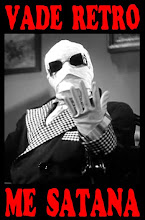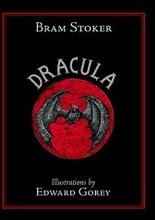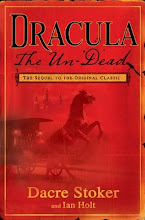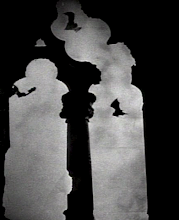
Bunnicula is a children's book series written by James Howe
(and his late wife Deborah in the case of "Bunnicula") about a
vampire bunny that sucks the juice out of vegetables. It is also
the name of the first book in the series, published 1979.

The story is centered on the Monroe family and their pets and is
told from the perspective of their dog Harold. The Monroes find
a bunny at the theater where they were watching a Dracula film.
Because of this, they name him Bunnicula. Their cat Chester,
however, is convinced Bunnicula is a vampire and attempts to
get Harold to help save the Monroes from the perceived menace.
A 1979 animated TV special (from Ruby-Spears) by the same
name was created based on the first book and aired on the ABC
Weekend Special. The animated special deviated heavily from the
novels and actively depicted Bunnicula using vampiric powers,
which did not occur in the novels.

The full name of the first book is Bunnicula: A Rabbit-Tale of
Mystery. The second and third books of the series are Howliday
Inn and The Celery Stalks at Midnight. Nighty-Nightmare followed
in 1987, followed by Return to Howliday Inn in 1993. In 1999,
Bunnicula Strikes Again!, was published. Bunnicula Meets Edgar
Allan Crow was published in 2006, and appears to be the final
book in the Bunnicula series.

Following the end of the Bunnicula series, James Howe began a
spin-off series called Tales from the House of Bunnicula, which
are 'written' by Howie, the dachshund puppy introduced into the
series in Howliday Inn. There is also a series called Bunnicula and
Friends: Ready To Read. They are a series of five picture books
about adventures of the characters from the stories. They are
aimed for beginning readers.

>>Characters throughout the series:
Harold – As the main character, despite Bunnicula being the
title-bearing character, Harold is an old, scruffy and loving dog
under the Monroes' care. He narrates the books, sometimes even
humorously claiming he would not even write the books if it weren't
for Bunnicula. He enjoys his life with the Monroe family, particularly
with the youngest child Toby, always being a diligent and loyal pet.
His longtime friend is Chester the cat, who also lives under the
Monroe household. Harold has a strong affection for chocolate
cupcakes, as well as other typical snacks such as cheese crackers
and fudge, despite the potential risk of food poisoning due to
chocolate consumption. He is a mongrel but is part Russian
wolfhound. He says that this is why he is able to recognize an
obscure dialect of Transylvania in the first book.

In the first book, Harold sees Bunnicula for the first time, as well
as seeing a bunny for the first time. While Bunnicula's
vampire-like activities do scare him a little, he holds no grudges
against the bunny, even befriending him. Unluckily, Chester, who
has an outrageously vivid imagination and is narrow-minded,
thinks Bunnicula is a real vampire and forces Harold to assist him
to kill the rabbit. All attempts fail, and finally Harold goes against
Chester's crazy attempts to do away with Bunnicula. Throughout
the series, Harold is portrayed the same way, albeit being a bit
dim-witted as the story progresses (which subjects him to crude
nicknames given to him by Chester). The other pet in the Monroe
household is the care-free dachshund puppy, Howie, and he
admires both Harold and Chester, as well as Bunnicula. Harold
is dubbed as "Uncle Harold" by the puppy. Throughout the series,
Harold remains unconvinced of Chester's belief that Bunnicula is
a vampire, and constantly rebuffs the ideas Chester has regarding
the rabbit.

Chester - The highly vivid cat who devours good literature. He was
given to Mr. Monroe as a birthday present, and the name "Chester"
was derived from G. K. Chesterton. Ever since Bunnicula's arrival,
Chester becomes increasingly aware that the bunny could be a
threat to the household ("Today vegetables, tomorrow the world!",
he exclaims at one point in reference to Bunnicula's "diabolical
plans" when trying to convince Harold of his belief that Bunnicula
is a vampire). He really wants to kill Bunnicula. Harold and
eventually Howie objects to that notion, but Chester has remained
firm that Bunnicula is a true vampire. Albeit an intellectual cat, he
becomes carried away with his imagination and
narrow-mindedness; Harold mentions in Nighty-Nightmare that
Chester's constant reading and watching horror movies have given
him "a reality leak that requires constant attention". He once tried
to kill Bunnicula by using a steak (not a stake), a mistake that
always greets him with embarrassing memories. Another time,
he led Harold and Howie on a chase around Centerville,
"murdering" vampire vegetables, which were in fact the leftover
meals from Bunnicula. Too many times he made crazy attempts
to eliminate Bunnicula, all of which naturally fail. He usually calls
both of his canine friends "dolts", "simpletons", or "idiots."
He is known not to apologize for his errors that greatly affect
Harold, instead referring them as "a slight misinterpretation in
the facts." He is also known as "Pop" to Howie, something that
he is still not completely used to.
Despite having a tense relationship with Bunnicula, deep down
he accepts him as one of the family, and in the final two books
of the series, Bunnicula Strikes Again! and Bunnicula meets
Edgar Allan Crow, becomes friends with Bunnicula. Chester was
named Fluffy for a short time before.

Bunnicula – The bunny with strange eating habits and strange
vampire-like qualities, Bunnicula came to the Monroe household
on a dark, stormy night. Toby found him in the theater, which
was at the time showing Dracula, and brought him home, where
Mrs. Monroe brought up the clever name Bunnicula. A note was
placed with Bunnicula when he was found, written in Russian
reading "please take care of my baby". Only Harold is able to read
the note. He is subjected to many murder attempts by Chester,
who thinks that the rabbit would eventually become carnivorous.
However, his "indestructible" stature proves to Chester that he
cannot be killed. Due to his young age, Bunnicula cannot talk—or
at the very least he doesn't speak at any point in the series,
indicating that he may be incapable of it— but exhibits similar
physical emotions all the same, such as winking or crying. His
eating habit enables him to bite onto vegetables and suck the
juice out of them, similar to the method by which Dracula dines.
Instead of buck teeth like all rabbits, Bunnicula has fangs. He
remains part of the Monroe family, often treated with the utmost
respect by everyone, including the other pets. Bunnicula, at the
end of Nighty Nightmare is revealed to have produced a litter of
offspring with a rabbit owned by a friend of Pete Monroe as part
of a project for the novels' equivalent of the boy scouts. At least
one of the offspring is stated by Pete as looking identical to
Bunnicula, and was briefly mentioned again in Bunnicula meets
Edger Allan Crow, where he was named "Sonnicula", due to his
being the son of Bunnicula and carrying an identical appearance
to his father. Sonnicula never made any direct appearances in
the series, being referred to only twice in passing during the
events in the series. In Nighty Nightmare, Chester's story implies
that Bunnicula's parents were vampire rabbits who were created
by a lonely vampire, though Chester merely made the entire
story up.

In the non-canon animated special, produced by Ruby-Spears,
Bunnicula's name is written in the note itself, to avoid having the
Monroes name him. The note is one of the few aspects of the
novel to carry over into the animated special, as Bunnicula is
found near a processing plant in the special. In the televised
version, when Bunnicula goes into his vampiric form, he sprouts
bat wings under his arms and his eyes turn yellow. His vampire
powers include flight, hypnosis, levitation, and telekinesis.
Chester's murder attempts do not take place in the special and
he ultimately decides that the idea that Bunnicula is a vampire
is "ridiculous", something which doesn't occur in the novels,
which has a touch of irony, since Bunnicula is blatantly shown
using his vampiric powers (in as far as the animated special is
concerned), Chester was correct in his belief of Bunnicula's
true nature.

Howie – The young, care-free, and sometimes dim dachshund
puppy who was adopted by the Monroes from Chateau Bow-Wow.
He was the runt of the litter and his parents were rare and valuable
long-haired dachshunds (who Chester secretly suspected of being
werewolves). He usually does not understand the seriousness of
matters, thinking that murdering vampire vegetables is a game
and chasing Bunnicula is a race. He did not even know what a
vampire was when Chester informed him about Bunnicula, though
up to date he does not think that the bunny is a danger. For an
unknown reason, he calls Harold and Chester "Uncle Harold" and
"Pop", respectively; while Harold is perfectly comfortable with his
nickname, Chester is still not completely used to his own. His
hobbies include chewing on the rug, eating, chasing cars,
and barking.
Robert Monroe – He is the husband of Ann Monroe and the father
of Peter and Toby Monroe. He works as a college professor, and
his knack for reading classical literature enabled Chester to read
as well. In the animated special, he is described by Harold as
being a scientist, rather than a college professor, and works at
the plant where Bunnicula is discovered.

Bunnicula Doll.
Ann Monroe- She is Robert's wife and the mother of Peter and
Toby Monroe. She thought up of the name Bunnicula by combining
"Bunny" and "Dracula". She had previously tried to name him
"Bun-Bun" and "Fluffy." Names like this seem to be a habit with
her because Harold and Chester were both called "Fluffy" for a short
time. Her occupation as a lawyer makes her a good and strict
mother. In the animated special, Ann Monroe is not described as
having any job other than being a housewife. She also does not
name Bunnicula in the special, as the name is included in the note
they find with him.
Peter Monroe – The oldest of two boys who slacks off often. He
usually bullies his younger brother Toby and the pets, except for
Bunnicula. Often selfish, Harold avoids him, but Howie finds him
intriguing, mainly because of the books he reads. The space under
his bed is very messy and, in addition to keeping a stuffed animal
named Puddikins under it for emergency hugs, many other stuff
has turned up such as Oreos, dirty socks and a notebook that
Harold gives Howie. Chester finds him indifferent.
Toby Monroe – The youngest of two, he is more dignified and
kinder than Peter. He likes to share his snacks with Harold during
his late-night readings, and is adored by Chester and Howie.
>>Books:
-Bunnicula
-Howliday Inn
-The Celery Stalks at Midnight
-Nighty Nightmare
-Return to Howliday Inn
-Bunnicula Meets Edgar Allan Crow
-Bunnicula Strikes Again!
>>Film:
Release date: 1979 USA
Main Crew:
Director: Charles A. Nichols (Cyrano 1974; Charlotte's Web 1973).
Producer: Ruby-Spears Entertainment.
Score: Dean Elliot.
Writer: Mark Evanier (based on the book by Deborah & James Howe).



>>Summary:
A vegetarian Vampire?! Two boys, the intelligent cat Morris and
Chester, a very laid-back dog, solve one of the most bizzare
mysteries ever. In an amazing series of nocturnal visitations,
vegetables are ruthlessly drained of their juices. Can the culprit
be a fluffy bunny-rabbit who answers to the name - Bunnicula?
Fonts:
Wikipedia
Vampyres Online
Stuffe & Nonsense
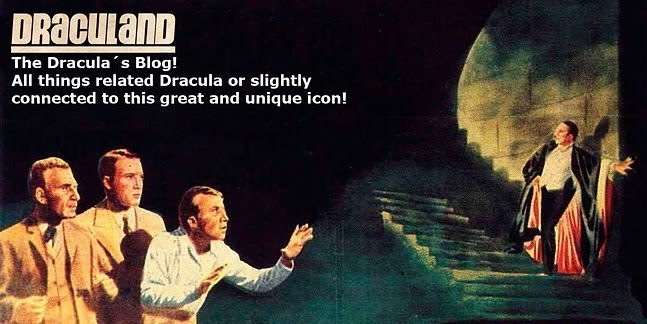





.jpg)
.jpg)
.jpg)
.jpg)
.jpg)
.jpg)
.jpg)
.jpg)
.jpg)
.jpg)
.jpg)
.jpg)
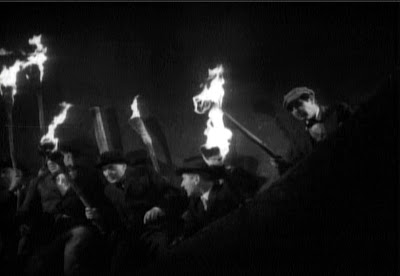.jpg)
.jpg)
.jpg)
.jpg)
.jpg)


























